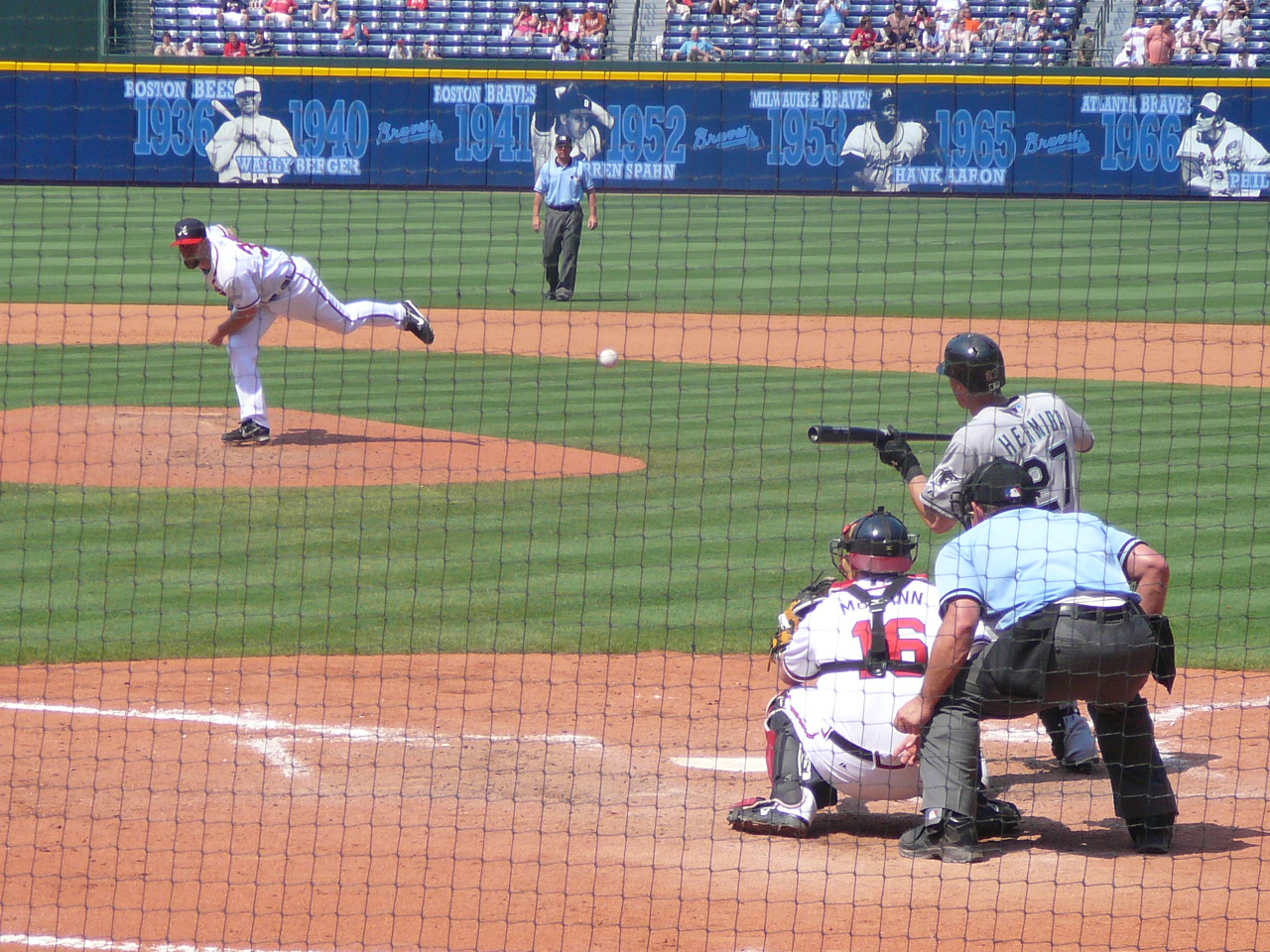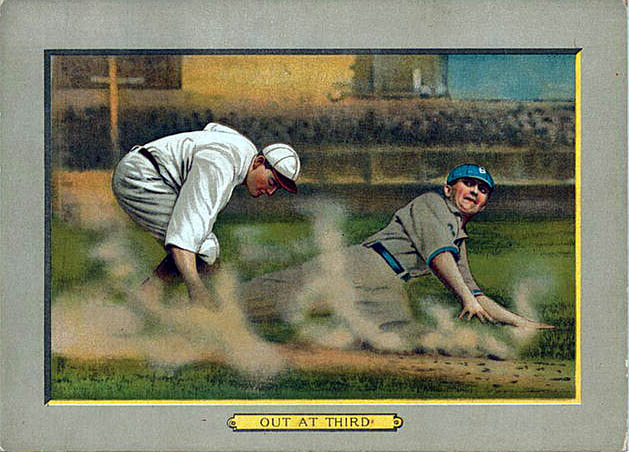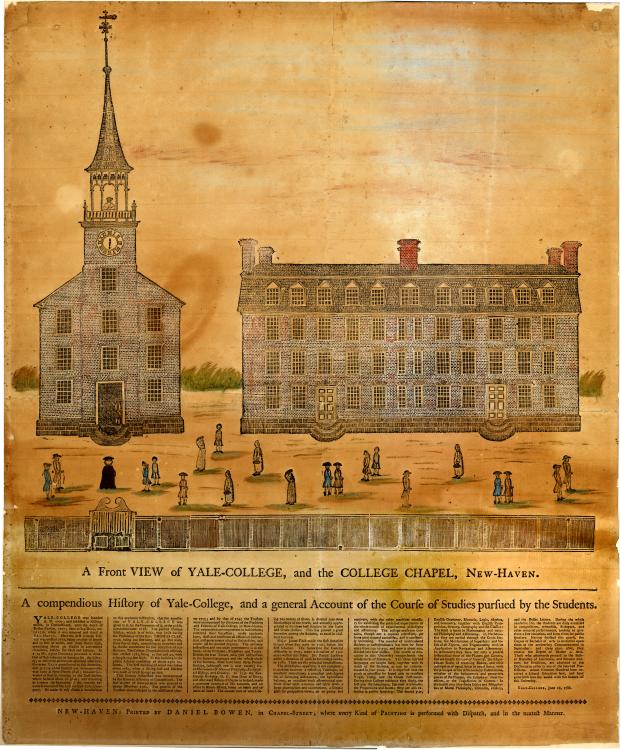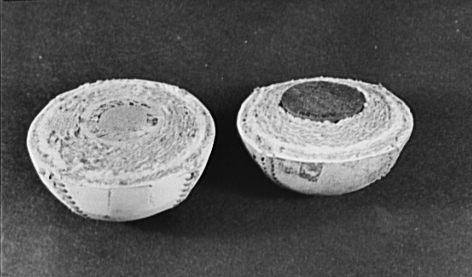|
Safety Squeeze
In baseball, the squeeze play or a squeeze bunt is a maneuver consisting of a sacrifice bunt with a runner on third base. The batter bunts the ball, expecting to be thrown out at first base, but providing the runner on third base an opportunity to score. Such a bunt is most common with one out. According to Baseball Almanac, the squeeze play was invented in 1894 by George Case and Dutch Carter during a college game at Yale University. In a safety squeeze, the runner at third takes a lead, but does not run towards home plate until the batter makes contact bunting. A play at home plate is possible. In a suicide squeeze, the runner takes off as soon as the pitcher begins the windup to throw the pitch, and before releasing the ball A ball is a round object (usually spherical, but sometimes ovoid) with several uses. It is used in ball games, where the play of the game follows the state of the ball as it is hit, kicked or thrown by players. Balls can also be used for s .... ... [...More Info...] [...Related Items...] OR: [Wikipedia] [Google] [Baidu] |
Baseball
Baseball is a bat-and-ball games, bat-and-ball sport played between two team sport, teams of nine players each, taking turns batting (baseball), batting and Fielding (baseball), fielding. The game occurs over the course of several Pitch (baseball), plays, with each play beginning when a player on the fielding team (baseball), fielding team, called the pitcher, throws a Baseball (ball), ball that a player on the batting team (baseball), batting team, called the Batter (baseball), batter, tries to hit with a baseball bat, bat. The objective of the offensive team (batting team) is to hit the ball into the field of play, away from the other team's players, allowing its players to run the Base (baseball), bases, having them advance counter-clockwise around four bases to score what are called "Run (baseball), runs". The objective of the defensive team (referred to as the fielding team) is to prevent batters from becoming Base running, runners, and to prevent runners base running ... [...More Info...] [...Related Items...] OR: [Wikipedia] [Google] [Baidu] |
Sacrifice Bunt
In baseball, a sacrifice bunt (also called a sacrifice hit) is a batter's act of deliberately bunting the ball, before there are two outs, in a manner that allows a baserunner to advance to another base. The batter is almost always put out, and hence sacrificed (to a certain degree that is the intent of the batter), but sometimes reaches base on an error or fielder's choice. In that situation, if runners still advance bases, it is still scored a sacrifice bunt instead of the error or the fielder's choice. Sometimes the batter may safely reach base by simply outrunning the throw to first; this is not scored as a sacrifice bunt but rather a single. A successful sacrifice bunt does not count as an at bat, does not impact a player's batting average, and counts as a plate appearance. Unlike a sacrifice fly, a sacrifice bunt is not included in the calculation of the player's on-base percentage. If the official scorer believes that the batter was attempting to bunt for a base hit a ... [...More Info...] [...Related Items...] OR: [Wikipedia] [Google] [Baidu] |
Baseball Field
A baseball field, also called a ball field or baseball diamond, is the field upon which the game of baseball is played. The term can also be used as a metonym for a baseball park. The term sandlot is sometimes used, although this usually refers to less organized venues for activities like sandlot ball. Specifications :''Unless otherwise noted, the specifications discussed in this section refer to those described within the Baseball Rules, under which Major League Baseball is played.'' The starting point for much of the action on the field is home plate (officially "home base"), a five-sided slab of white rubber. One side is long, the two adjacent sides are . The remaining two sides are approximately and set at a right angle. The plate is set into the ground so that its surface is level with the field. The corner of home plate where the two 11-inch sides meet at a right angle is at one corner of a square. The dimensional specifications are technically inconsistent because ... [...More Info...] [...Related Items...] OR: [Wikipedia] [Google] [Baidu] |
Bunt (baseball)
A bunt is a batting (baseball), batting technique in baseball or softball, fastpitch softball. Official Baseball Rules define a bunt as follows: "A bunt is a batted ball not swung at, but intentionally met with the bat and tapped slowly within the infield." To bunt, the batter loosely holds the baseball bat, bat in front of home plate and intentionally Batted ball, taps the ball into play. A properly executed bunt will create weak contact with the ball and/or strategically direct it, forcing the infielders to make a difficult defensive play to record an out (baseball), out. Technique The strategy in bunting is to ground the ball into fair territory, as far from the fielders as possible but within the Baseball, infield. This requires not only physical dexterity and concentration, but also an awareness of the baseball fielding positions, fielders' positions in relation to the baserunner or baserunners, their likely reactions to the bunt, and knowledge of the pitcher's most likely pit ... [...More Info...] [...Related Items...] OR: [Wikipedia] [Google] [Baidu] |
Out (baseball)
In baseball, an out occurs when the umpire (baseball), umpire rules a Batter (baseball), batter or baserunner out. When a batter or runner is out, they lose their ability to score a Run (baseball), run and must return to the dugout until their next turn at bat. When three outs are recorded in a half-inning, the batting team's turn expires. To signal an out, an umpire generally makes a fist with one hand, and then flexes that arm either upward, particularly on pop flies, or forward, particularly on routine plays at first base. Home plate umpires often use a "punch-out" motion to signal a called strikeout. Ways of making outs * The most common ways batters or runners are put out are when: ** The batter strike out, strikes out (they make three batting mistakes, known as ''strikes'', without hitting the ball into fair territory); ** The batter fly out, flies out (they hit the ball and it is caught before landing); *** A baserunner Tag up, fails to return to their time-of-pitch base ... [...More Info...] [...Related Items...] OR: [Wikipedia] [Google] [Baidu] |
Run (baseball)
In baseball, a run is scored when a player advances around first, second and third base and returns safely to home plate, touching the bases in that order, before three outs are recorded and all obligations to reach base safely on batted balls are met or assured. A player may score by hitting a home run or by any combination of plays that puts him safely "on base" (that is, on first, second, or third) as a runner and subsequently brings him home. Once a player has scored a run, they may not attempt to score another run until their next turn to bat. The object of the game is for a team to score more runs than its opponent. The Official Baseball Rules hold that if the third out of an inning is a force out of a runner advancing to any base then, even if another baserunner crosses home plate before that force out is made, his run does not count. However, if the third out is not a force out, but a tag out, then if that other baserunner crosses home plate before that tag out i ... [...More Info...] [...Related Items...] OR: [Wikipedia] [Google] [Baidu] |
Baseball Almanac
Baseball Almanac is an interactive baseball encyclopedia with over 500,000 pages of baseball facts, research, awards, records, feats, lists, notable quotations, baseball movie ratings, and statistics. Its goal is to preserve the history of baseball. It serves, in turn, as a source for a number of books and publications about baseball, and/or is mentioned by them as a reference, such a''Baseball Digest'' an ''Baseball's Top 100: The Game's Greatest Records'' Dan Zacho ... [...More Info...] [...Related Items...] OR: [Wikipedia] [Google] [Baidu] |
Yale University
Yale University is a Private university, private Ivy League research university in New Haven, Connecticut, United States. Founded in 1701, Yale is the List of Colonial Colleges, third-oldest institution of higher education in the United States, and one of the nine colonial colleges chartered before the American Revolution. Yale was established as the Collegiate School in 1701 by Congregationalism in the United States, Congregationalist clergy of the Connecticut Colony. Originally restricted to instructing ministers in theology and sacred languages, the school's curriculum expanded, incorporating humanities and sciences by the time of the American Revolution. In the 19th century, the college expanded into graduate and professional instruction, awarding the first Doctor of Philosophy, PhD in the United States in 1861 and organizing as a university in 1887. Yale's faculty and student populations grew rapidly after 1890 due to the expansion of the physical campus and its scientif ... [...More Info...] [...Related Items...] OR: [Wikipedia] [Google] [Baidu] |
Pitch (baseball)
In baseball, the pitch is the act of throwing the baseball toward home plate to start a play. The term comes from the Knickerbocker Rules. Originally, the ball had to be thrown underhand, much like "pitching in horseshoes". Overhand pitching was not allowed in baseball until 1884. The biomechanics of pitching have been studied extensively. The phases of pitching include the windup, early cocking, late cocking, early acceleration, late acceleration, deceleration, and follow-through. Pitchers throw a variety of pitches, each of which has a slightly different velocity, trajectory, movement, hand position, wrist position and/or arm angle. These variations are introduced to confuse the batter and ultimately aid the defensive team in getting the batter or baserunners out. To obtain variety, and therefore enhance defensive baseball strategy, the pitcher manipulates the grip on the ball at the point of release. Variations in the grip cause the seams to catch the air differently, ... [...More Info...] [...Related Items...] OR: [Wikipedia] [Google] [Baidu] |
Baseball (ball)
A baseball is the ball used in the sport of baseball. It consists of a rubber or cork center wrapped in yarn and covered with white natural horsehide or cowhide, or a synthetic composite leather. A regulation baseball is in circumference i.e. in diameter, with a weight of . The leather cover is commonly formed from two saddle-shaped pieces stitched together, typically with red-dyed thread. There are 108 stitches on a regulation baseball. That stitching plays a significant role in the trajectory of a thrown baseball due to the drag caused by the interaction between the stitching and the air. Controlling the orientation of the stitches and the speed of the ball's rotation allows a pitcher to affect the behavior of the pitched ball in specific ways. Commonly employed pitches include the curveball, the slider, the two-seam fastball, the four-seam fastball, the sinker, the cutter and the changeup. History In the early, mid-1800s days of baseball, there was a great variety ... [...More Info...] [...Related Items...] OR: [Wikipedia] [Google] [Baidu] |
Baseball Terminology
This is an alphabetical list of selected unofficial and specialized terms, phrases, and other jargon used in baseball, along with their definitions, including illustrative examples for many entries. 0–9 0 :"Oh and ..." See count. 1 The number 1 in baseball refers to the pitcher's position, a shorthand call for throwing to first, a single hit, and a fastball sign. 1-2-3 inning :An inning in which a pitcher faces only three batters and none safely reaches a base. "Three up, three down." 1-2-3 double play :A double play in which the pitcher (1) fields a batted ball and throws home to the catcher (2), who retires a runner advancing from third. The catcher then throws to the first baseman (3) to force out the batter. These almost always happen with the bases loaded. 1-6-3 double play :The pitcher (1) fields a batted ball and throws to the shortstop (6) to force out a runner advancing to second. The shortstop then throws to the first baseman (3) to force out th ... [...More Info...] [...Related Items...] OR: [Wikipedia] [Google] [Baidu] |
Baseball Plays
Baseball is a bat-and-ball sport played between two teams of nine players each, taking turns batting and fielding. The game occurs over the course of several plays, with each play beginning when a player on the fielding team, called the pitcher, throws a ball that a player on the batting team, called the batter, tries to hit with a bat. The objective of the offensive team (batting team) is to hit the ball into the field of play, away from the other team's players, allowing its players to run the bases, having them advance counter-clockwise around four bases to score what are called " runs". The objective of the defensive team (referred to as the fielding team) is to prevent batters from becoming runners, and to prevent runners advancing around the bases. A run is scored when a runner legally advances around the bases in order and touches home plate (the place where the player started as a batter). The initial objective of the batting team is to have a player rea ... [...More Info...] [...Related Items...] OR: [Wikipedia] [Google] [Baidu] |






